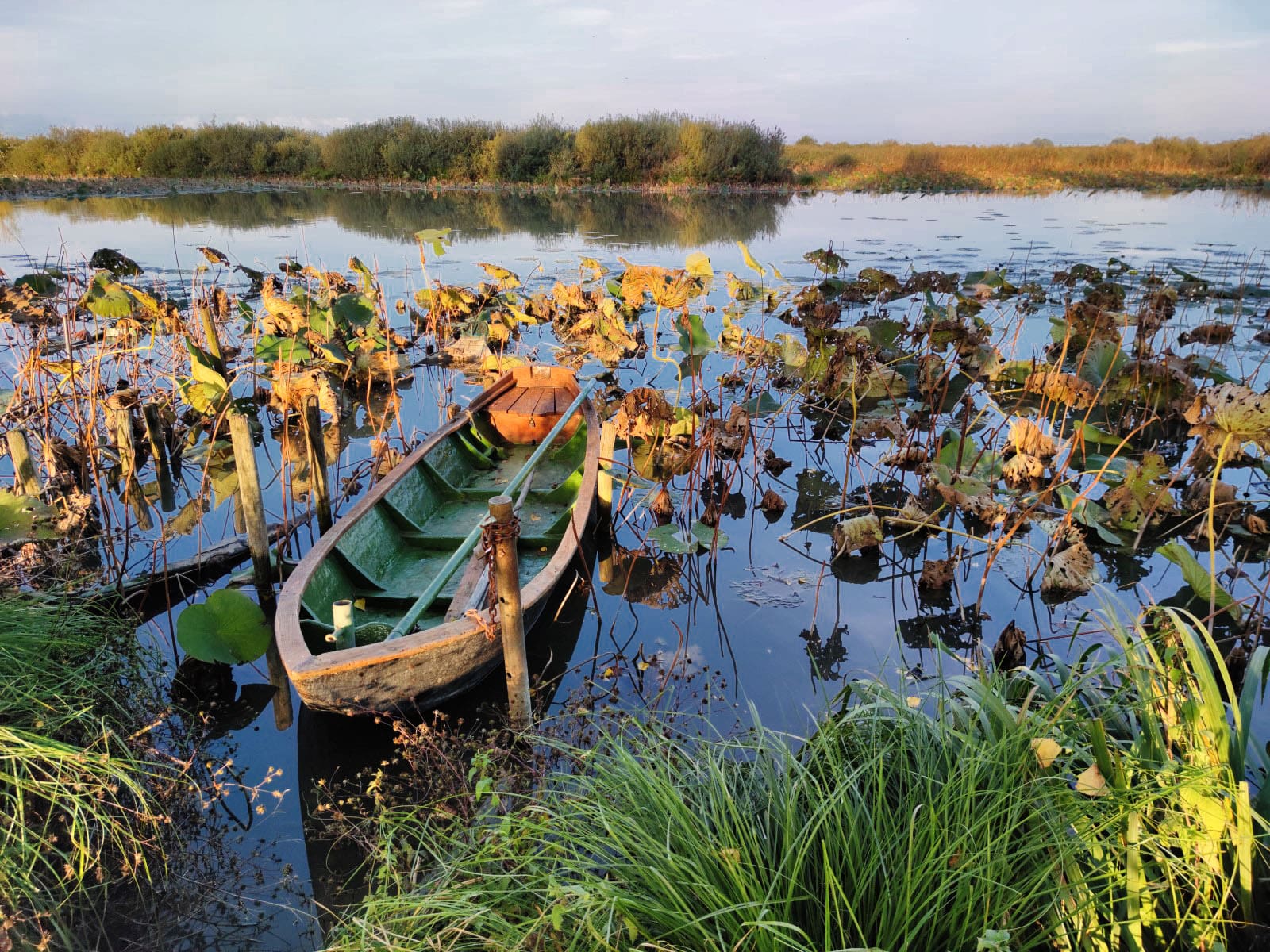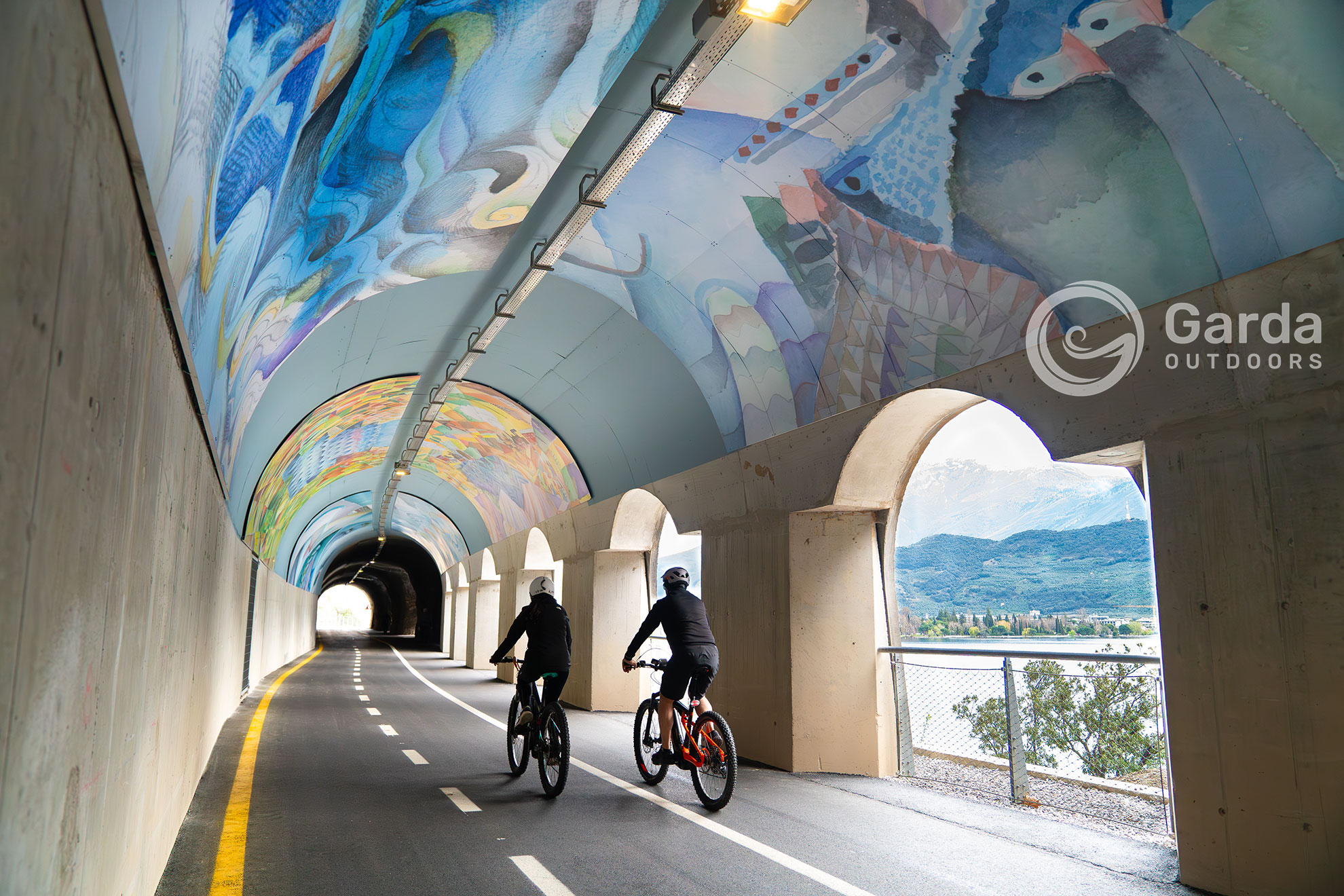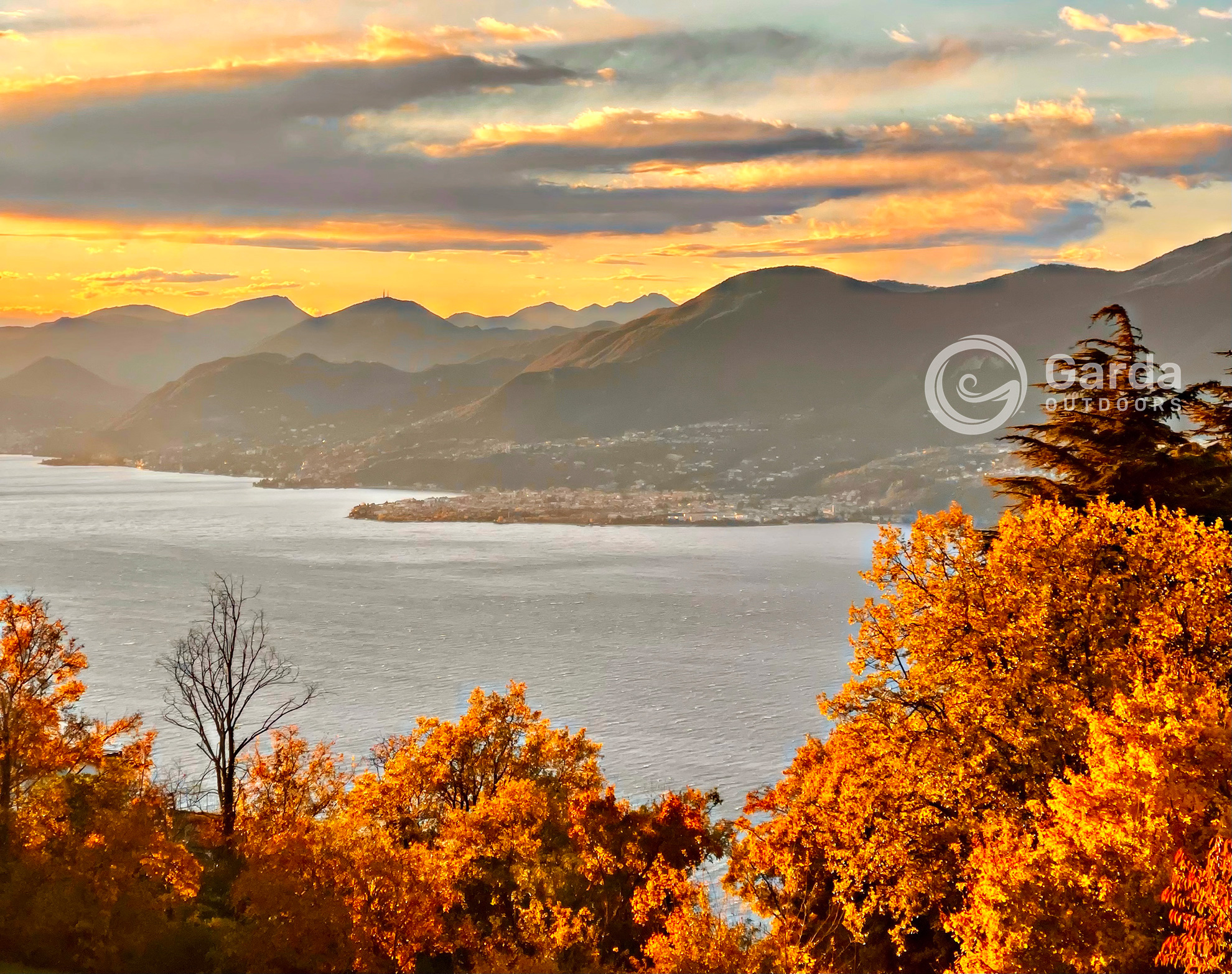Landscapes immersed in nature, placid villages that are open-air film sets, wonders of art and places full of history: the most beautiful Italian villages in Mantua are an exceptional discovery! Perfect destination for an unusual and charming weekend just a few kilometers from Lake Garda, for those who want to stay away from the chaos, but love authentic places, friendly people, drink and eat divinely!
In this article we will talk about the main Mantuan villages that have made the history of this territory: Sabbioneta, San Benedetto Po, Pomponesco, Grazie di Curtatone, Castellaro Lagusello, Volta Mantovana, Solferino, Monzambano, Rivarolo Mantovano, Goito and Castel Goffredo.
Sabbioneta.
When Mantua became a Unesco World Heritage Site in 2008, Sabbioneta was also joined as an ideal Renaissance city.
Sabbioneta was already a medieval village, entrusted at the end of the 15th century to the second son of Ludovico II Gonzaga, Gianfrancesco (both represented in the Camera degli Sposi by Mantegna): thus the county of Sabbioneta was born. But in the sixteenth century Vespasiano Gonzaga wanted to create an ideal city, from scratch: he built from scratch the Palazzo Grande (the current Palazzo Ducale – residence of the Duke when he was in government), the Teatro all’Antica (the first example of a permanent theater in Europe , built by Vincenzo Scamozzi, former architect of the Olympic Theater in Vicenza) and the Palazzo Giardino (place of leisure and rest) with the Galleria degli Antichi (the longest in Italy after that of the Maps in the Vatican and that of the Uffizi in Florence ). The shape is a six-pointed star (six bastions) with two gates, not aligned with each other (also for military reasons): Porta Vittoria towards Cremona, Porta Imperiale towards Mantua. In short, even at the level of fortifications it was at the forefront.
Sabbioneta was a city-state: it minted its own currency, had a printing house and two academies: one of philosophy and one of mathematics. For Vespasiano, culture was important and everyone could participate in the lessons. Unfortunately the 15-year-old son died, Vespasiano was left without heirs; another marriage was unsuccessful and the duchy returned to Mantua. But Sabbioneta was no longer modified and this is its fortune: it has crystallized in all its beauty and great historical heritage.
To visit there are also some beautiful religious buildings: the Church of Santa Maria Assunta in Cielo, Oratory of San Rocco, Church of the Beata Vergine Incoronata (Mausoleum of Vespasiano). More info here.
In the surroundings of Sabbioneta we point out the spectacular Church of Sant’Antonio Abate in Villa Pasquali and a little further north, the pontoon bridge over the Navarolo canal in existence since 1976 (to find it inserted in the navigator “via G. Garibaldi Sabbioneta”). The bridge can still be crossed by car. On the other hand, you are facing the Torrazzo Gonzaghesco of Commessaggio, with a splendid view of the town and its colorful houses.
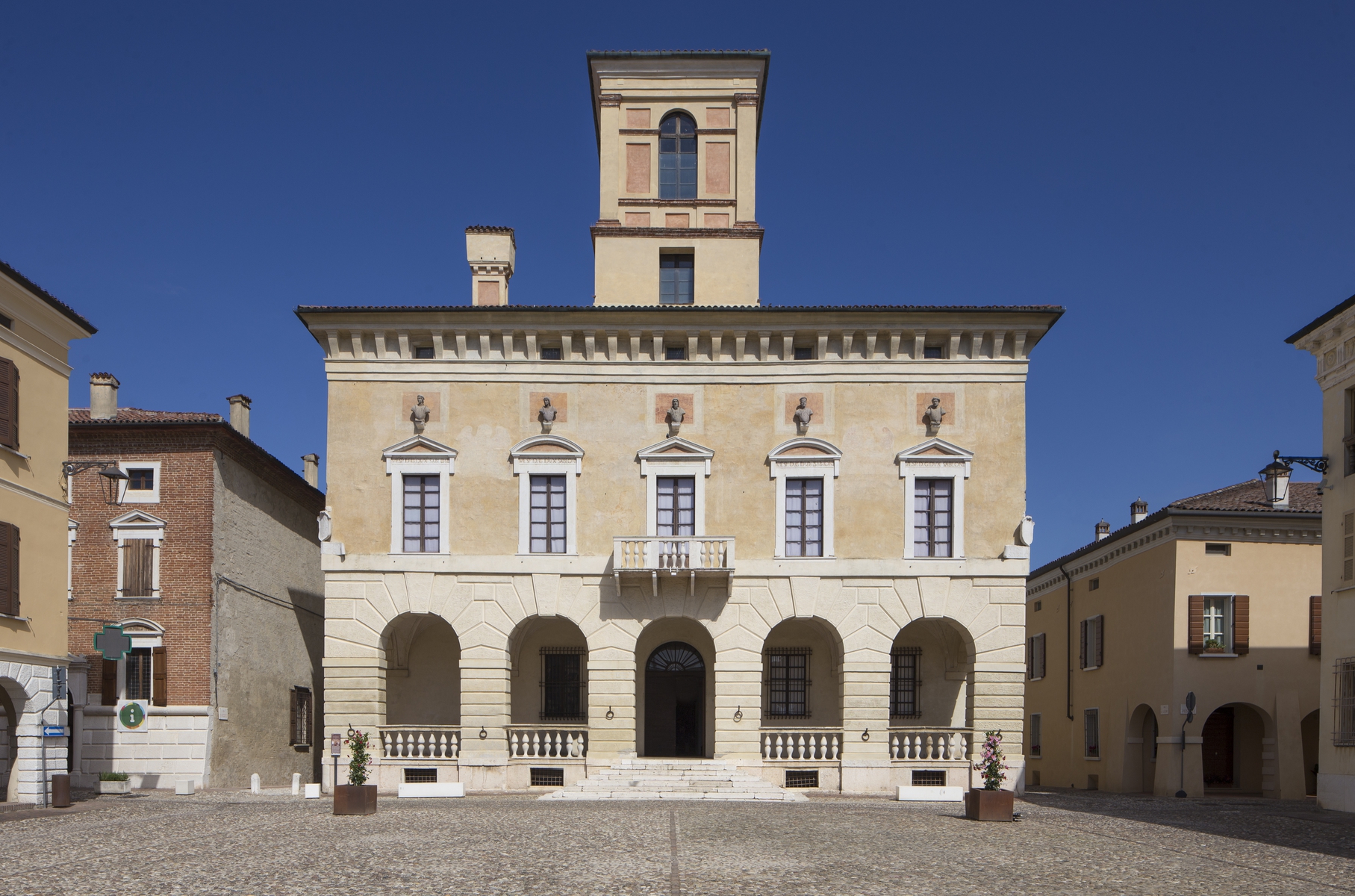
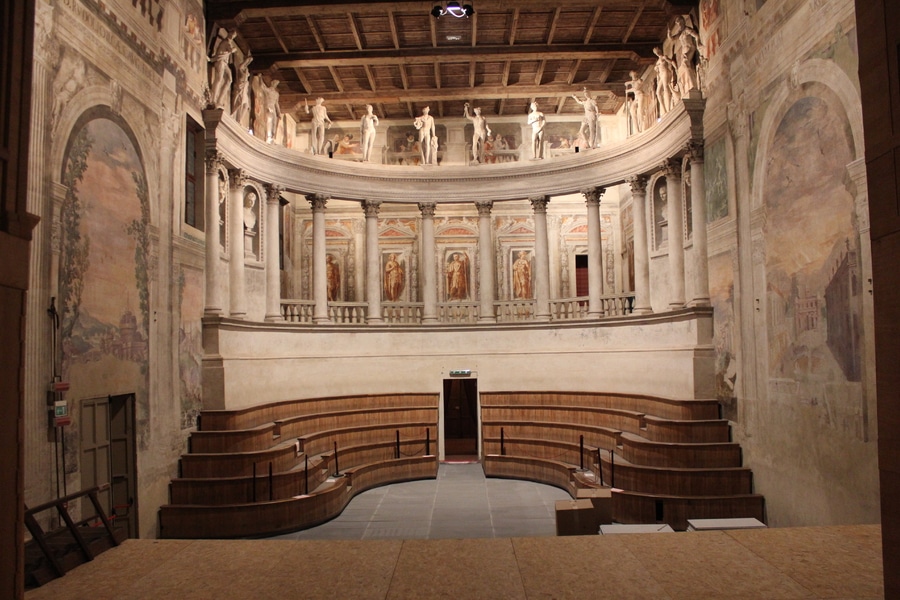
San Benedetto Po.
San Benedetto Po, south of the river Po, is closely linked to the Abbey of San Benedetto in Polirone, one of the most important Cluniac sites in Europe. The monastery is called del Polirone, because it was on a protected island between the Po canal and the Lirone canal. Then when the river was channeled, the great Po we know today (around 1200) was born.
It was founded in 1007 by Tedaldo di Canossa (Matilde’s grandfather) on land donated by the family. He built a small church, handing it over to the Benedictine monks; in the following 700 years it became one of the largest monastic complexes in Italy: just think that between the 1300s and 1500s it was more important than Cassino! In 1420 it came under the influence of the Gonzagas who entrusted it to the congregation of Santa Giustina of Padua; this led to the involvement of Giulio Romano who renovated the church. The history of the monastic complex ended with Napoleon, who suppressed it in 1797. The 2012 earthquake in Emilia, a border land, unfortunately caused extensive damage that has now been fixed.
The walls that protected the monastery are no longer there, replaced or incorporated by houses that formed the village. Then the immense Piazza Teofilo Folengo, open and irregular, extends on two sides of the former monastery. Formerly because today it no longer exists: now (apart from the church) it is owned by the Municipality and its rooms are used for various activities: there is a kindergarten, a library, a social center.
On the left, looking at the church, you will find the large Cloister of San Benedetto; it has only two sides, because a portico was plugged by Giulio Romano to build the internal chapels of the church, while the last one was demolished in the 19th century; so it became part of the huge square, a natural corner with a green lawn and some flowers. It is the largest of the 3 remaining cloisters (out of 5 that were); passing through it gives a nice play of views with the arches and the church as a background.
A few steps and you reach the cloister of San Simeone, an oasis of peace and silence. It is named after the Armenian hermit monk who apparently died here. Wonderful Lombard late Gothic all in terracotta, with geometric box hedges and pomegranate trees. Giulio Romano had the vaults frescoed with stories from the life of San Simeone. One part is connected to the old oratory of Santa Maria, the original part of the church; after all this was the central cloister of the monastery: the others were arranged on all four sides.
The former refectory can be visited and overlooks the square: it is close to the Cloister of San Benedetto. In the twentieth century it became a button factory and therefore the frescoes on the ceiling and walls are very damaged. It now houses an incomplete perspective attributed to Correggio around the Last Supper by Girolamo Bonsignori; in fact if you approach it you will see that the tablecloth is embroidered on it. Then there are two statues by Begarelli, whom Vasari called the Michelangelo of terracotta: a San Simeone and a Madonna in reinforced terracotta, then covered in stucco and polished to look like marble. The only fragment of the original Romanesque facade by Wiligelmo (the same artist of the Modena Cathedral) and some modern paintings are also exhibited.
In the basement there are the small cellars, home to the archeology part of the civic museum: Mantuan ceramics and ancient finds from the church. Followed by the large sixteenth-century cellars with the large collection of work carriages; finally, the tools for the production of wine: in fact it was the monks who made the sparkling wine of Lambrusco and champagne for the first time in France.
The abbey basilica is the jewel of San Benedetto Po and is still part of the network of Cluniac sites. It was modified over the centuries: after the first ancient church, the father of Matilde and Matilde di Canossa herself enlarged it in Romanesque and Gothic style. The genius of Giulio Romano incorporated these architectures giving them grace and homogeneity; in detail he doubled the nave and incorporated a portico of the cloister to create the side chapels. He also remade Wiligelmo’s facade, on which a new facade was superimposed in the 1700s: the ancient rose window can still be seen in the center.
The statues of the saints on the right side of the churchyard give charm and are excellent photographic inspirations.
Inside the church the vault is marvelous, with geometric shapes with grotesques inside, a distinctive feature of Giulio Romano.
The oldest area of the church is primarily that of the altar; closed by a metal gate with the effigy of St. Benedict. Behind, hidden from view, the choir, formed by carved wooden stalls arranged in a U shape. Here the monks sat to sing, with a revolving lectern in the center. Around the ambulatory of the apse, the sixteenth-century statues by Begarelli stand out.
The original part of the basilica, however, is the Oratory of Santa Maria, which was the primeval church. Matilde di Canossa reversed it and connected it to the larger church he was building. Here is the first tomb of Matilda di Canossa, since she died 3 km from here. It is still found in the apse, with a floor mosaic from 1151 with the 4 cardinal virtues and some symbols linked to the figure of Matilda.
Instead, on the other side of the church there is the second tomb of Matilda, from the sixteenth century, supported by 4 red lions. Then in 1633 the body was moved to St. Peter’s Basilica in Rome. Next to it, the sacristy with large wooden cabinets and geometric frescoes with grotesques, also by Giulio Romano.
In the surroundings of San Benedetto Po we point out the pontoon bridge of Torre Oglio, the oldest pontoon bridge in the Oglio. Until 2000 there was the figure of the bridge man who managed it, a historical profession handed down from generation to generation, now replaced by automated systems which, however, are less sensitive to the conditions of the river: at the slightest alert it is closed to traffic, while the bridge bridge was more dynamic in reading the conditions and closed it only if actually necessary. Right here Ligabue (a very famous italian singer) shot a scene from Radiofreccia.
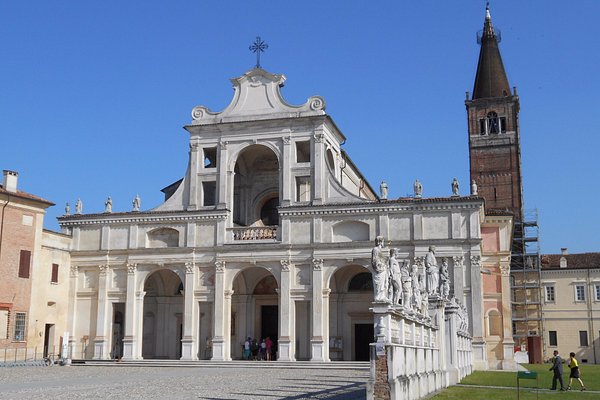
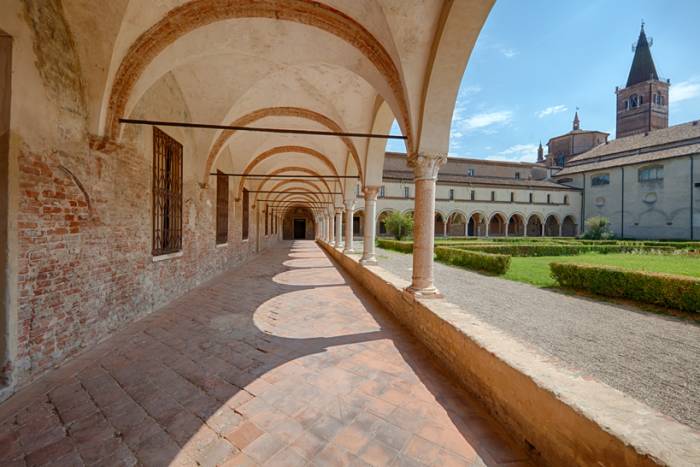
Pomponesco.
The village of Pomponesco rises on the left bank of the Po and its history has always been closely linked to the river and to the businesses that were entertained here: it has its own marina and still retains the air and atmosphere of a river village. The territory of Pomponesco passed from hand to hand between the Etruscans and the Gauls but its name derives from the period in which the Roman Pompea family settled in the area: this lineage was not the only one to appreciate the Mantuan area and the town ended up among the possessions of several powerful owners, such as the Este, the bishopric of Cremona, and the Gonzagas of Mantua.
It was precisely a Gonzaga who forever sealed the fate of Pomponesco, transforming the small village into an idealistic and glorious dream: Giulio Cesare Gonzaga. The urban design studied at the table upset the structure of the quiet river village and here Julius Caesar established his residence and brought his court, endowing Pomponesco with enormous prestige. After the end of the Gonzaga dynasty and the loss of importance of trade on the river, Pomponesco still remains a jewel of inestimable value, suspended in the quiet of the Mantua countryside.
The urban plan of Pomponesco has remained practically unchanged since the time of Giulio Cesare Gonzaga, who at the end of the sixteenth century made two directions depart from his central castle that divided the town into four distinct and symmetrical areas, still visible. Today, however, in place of the ancient castle of the Marquis, demolished by the French in the eighteenth century, stands the splendid Piazza XXIII Aprile, enclosed by palaces with arcades where Gonzaga’s courtiers once lived. Almost all the buildings that surround the clearing can be dated between 1590 and 1630 and many still retain the original wooden ceilings and in rare cases even the frescoes of the time. Piazza XXIII Aprile as well as architecturally splendid is also home to 11 restaurants, tavern shops and typical wine bars.
On the square there are, facing each other, the Town Hall and the fourteenth-century church of Santa Felicita and the Sette Fratelli Martiri, which outline the profile of the widening with their high towers. Another point of great interest in the village is the elegant Palazzo Cantoni, once owned by a wealthy Jewish family who moved to Pomponesco to carry out commercial activities. An illustrious descendant of this family is Alberto Cantori, a famous writer who rests today in the Jewish cemetery, right near the Palace.
The 1900 Theater completes the cultural offer of the little Pomponesco: one of the town theaters, very popular in the Po Valley in the last century.Among the events and events that make Pomponesco the fulcrum of history and culture, there is the fact that the city was the birthplace not only of the aforementioned Cantori, but also of Gerolamo Trenti, one of the best-known exponents of Lombard landscape art of the nineteenth century and that the town was repeatedly chosen by great directors as the location for their films: Zavattini, Soldati , Bertolucci and even Brass and Terence Hill, have grasped the scenic charm of the country making it the set for their scenes.
A few kilometers from the village, the Lombardy regional natural reserve of the Garzaia di Pomponesco is an area of 23 hectares made up of wooded areas on which numerous white willows have found fertile soil, cradle of volatile species such as Night Herons, Egrets, Knights of Italy and Owls. On the pretty port of Pomponesco it is then possible to admire typical casoni on the river and along the banks of the Po you can glimpse bends and sandy beaches, once used as summer camps for children and today a place for excursions, walks and incredible relaxation.
Among the most important Pomponesco events are the Pomponesco Thanksgiving Festival, staged in November and organized by the Pomponesco Young Farmers Association in honor of the anniversary during which farmers thanked the Lord for the harvest obtained during the year. You can taste typical products and see unusual races with agricultural vehicles. At the end of August, on the other hand, two really curious village festivals take place. The first is dedicated to Lùadèl, that is a very tasty and famous type of bread in these areas that already in the time of the Gonzagas served to attest to the attainment of the right temperature in the ovens of the houses. Its name derives from the word yeast. To taste it all year round, you can go to the Il Cesto Bakery.
The second festival at the end of summer is instead that of Pulàc. The term derives from pulàca which in Mantuan dialect means laziness and listlessness: the pulàca festival nicely elects the most slacker among the candidates of the country, in a goliardic and festive atmosphere. At Easter, on the other hand, a scenic Via Crucis takes place in the streets of the town, during which dozens of extras recall the biblical scene with heartfelt participation and a profound Christian spirit, giving life to an event not to be missed.
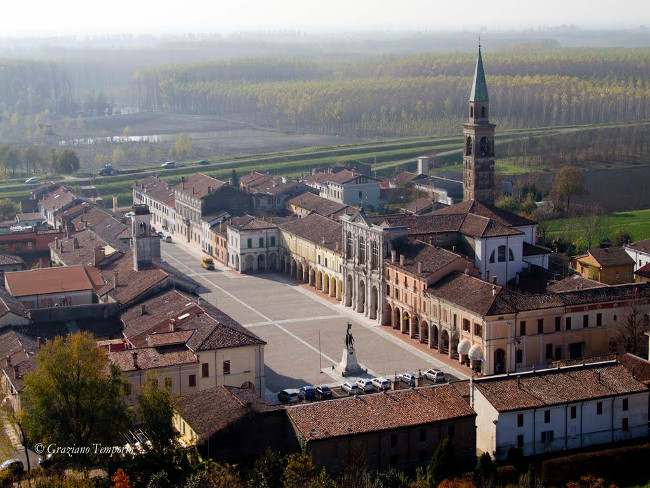
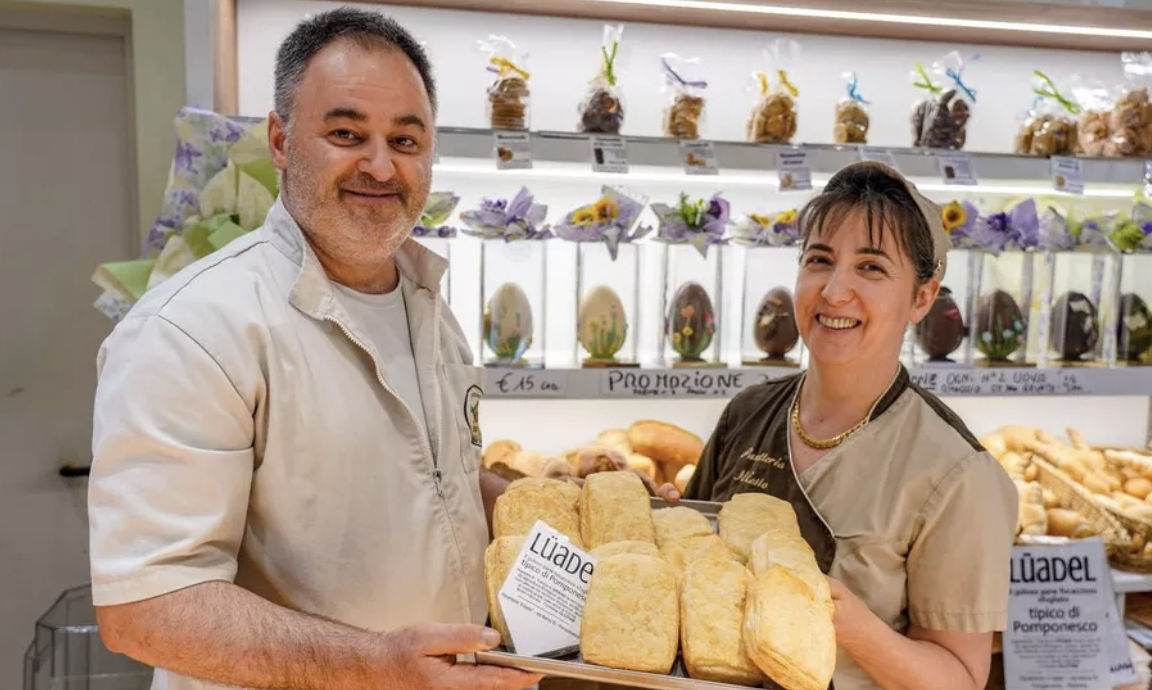
Grazie di Curtatone.
Grazie di Curtatone, a fishing village, was built around the Sanctuary of the Beata Vergine Maria delle Grazie and still today it is a group of a few houses gathered around the large Piazzale Santuario where the large church stands.
Among the reeds there was an altar with the image of the Madonna and Child to which the fishermen of the Mincio made prayers and ex-votos for abundant fishing: thus the village was born in the 11th-12th century. In 1398 when the plague struck Mantua, Francesco Gonzaga also made an ex-voto to the Madonna delle Grazie; the city was saved and the architect Bartolino da Novara erected a large Gothic sanctuary, entrusted to the Franciscan friars. Bequests and donations made the complex rich: some great Mantuan families built their chapels here and even Giulio Romano was called to embellish the church: therefore the sanctuary has sixteenth-century forms. His work is especially noticeable inside; in particular it was used as a mausoleum for some members of the Gonzaga family, including Baldassarre Castiglione.
But then it lost importance: in 1782 the sanctuary was transformed into a hospital and the subsequent Napoleonic spoliation deprived it of the most important ex-votos.
Inside, the frescoes in the lunettes of the portico illustrate the history of the church (from right to left): from the fishermen’s chapel, to the plague, to the prayer of Francis I (1399), then the works and inauguration in 1406.
Outside the sanctuary is not particularly striking, while inside it is very particular, not to say strange. There is even a hanging crocodile! Above all, we note the scaffolding of the nave with the many ex-votos: life-size mannequins with clothes and armor specially made by the Franciscans who ran the convent. In each lunette the moment in which the Madonna intervened is represented (everything is described in triplets below – you will find incredible stories). Then on the columns fetishes with parts of the body of wax (those that had to heal): hearts, hands, noses, breasts. Pure popular devotion.
At the bottom right at the top, the great personalities who came here are represented: Pope Pius II Piccolomini, Emperor Charles V and Philip II.
On the sides of the nave are the chapels of the wealthiest families of Mantua, closed with gates because they are embellished with gold; the first on the right is the Chapel of San Bonaventura with frescoes by Giulio Romano on the ceiling and the tomb of Baldassarre Castiglione. In the main altar there is the Madonna delle Grazie, very ancient, and the wonderful votive temple designed by Giulio Romano frames it.
We also point out the Fiera delle Grazie, which has existed since 1425. It takes place every 15 August in the large square of the church and sees the Madonnari at work, which they draw on the square with colored chalk.
What to do also in Grazie di Curtatone? An excursion on the Mincio River! Continue along the small street behind the church that takes you to a beautiful park on the banks of the river: right there is the dock for a boat ride with I Barcaioli del Mincio. You will be able to see the flora and fauna of the area and in the height of summer admire the spectacular blooming of the lotus flower. A unique excursion of its kind.
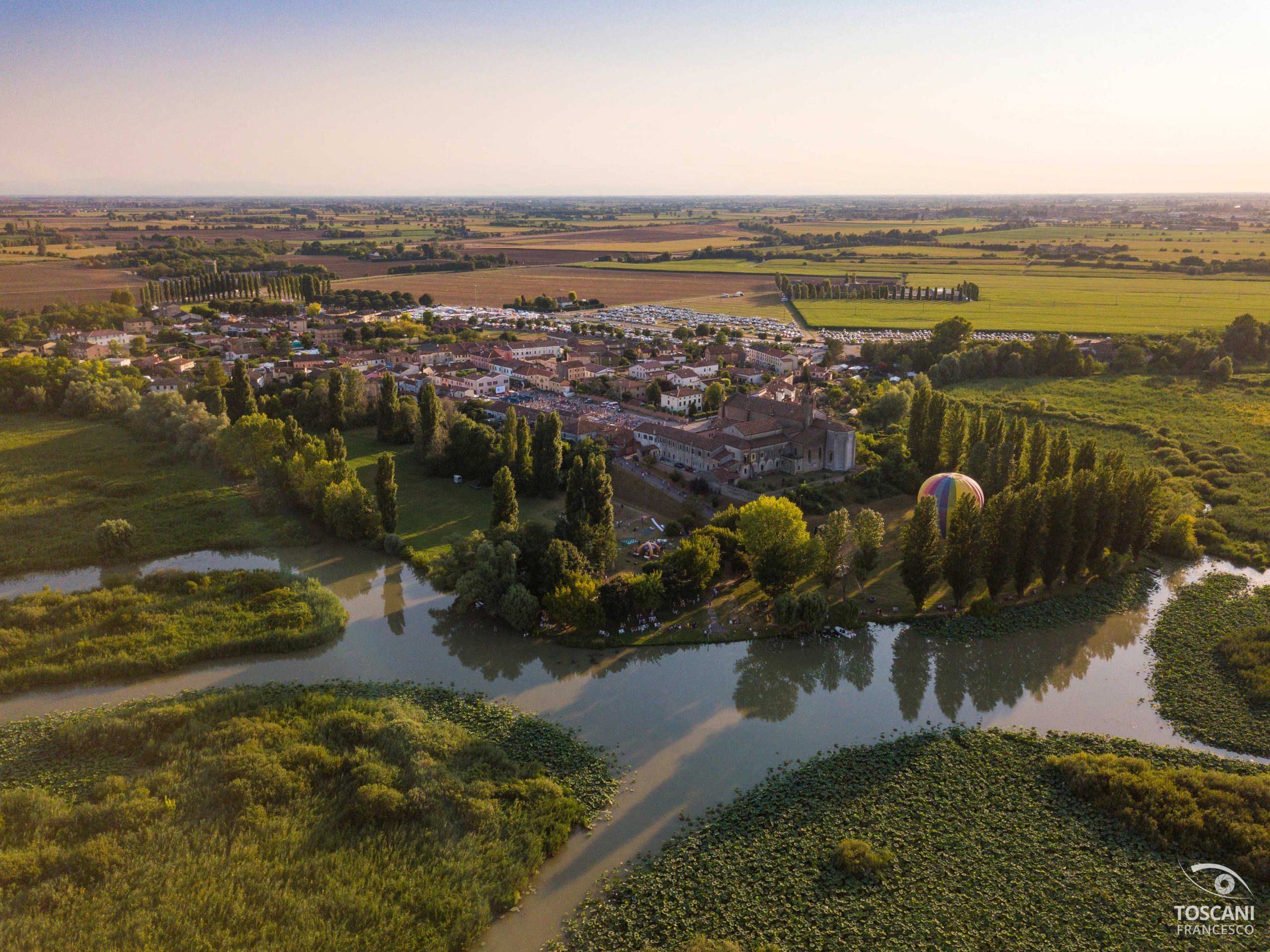
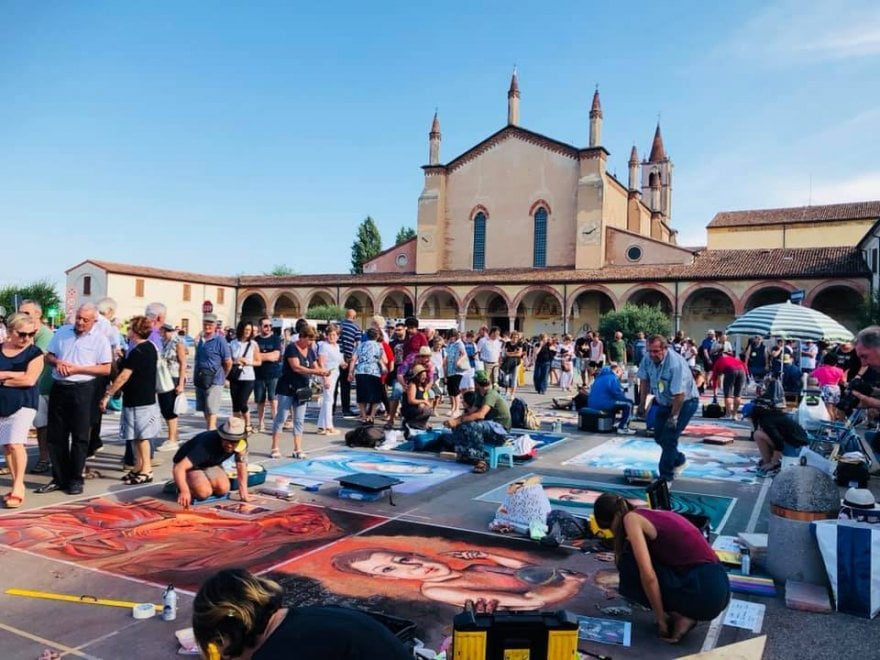
Castellaro Lagusello.
Castellaro Lagusello a tiny village that contends with Borghetto sul Mincio for supremacy among the most admired and visited villages of the moraine belt of Lake Garda and also shares its origins and structure: in fact, not mentioning the pile-dwelling settlements dating back to the Bronze Age in the area of the pond that laps it, we refer here to its characteristics of a fortified village as it was from 1000 to 1600, the century in which it changed its typical shape to become the residence of the Arrighi Counts.
Upon entering, you pass through a door once equipped with a drawbridge, dominated by a square tower recently restored and made practicable and, leaving the baroque church dedicated to St. Nicola, the nineteenth-century Villa Arrighi and the small lake below, a wildlife and floral oasis of striking beauty and considerable interest, overlooks.
The building is made up of stone and plaster houses, generally on two floors, recovered and very well maintained, an indication of the care lavished by the inhabitants to make the visit pleasant for the many tourists who reach this location.
To get to Castellaro, follow the municipal road that goes from Pozzolengo to Cavriana: from here, in fact, a few hundred meters before the village, you have the opportunity to observe its characteristic profile, as well as the relationship with the lake below and the beautiful countryside that extends west. Also from this point it is possible to take a dirt road that goes around the lake, without however approaching its banks, largely covered by a rather dense native vegetation that does not allow you to easily reach the shore.
From here to Monzambano, of which Castellaro Lagusello is a fraction, a very particular rural reality opens up, a “little Tuscany” made up of gentle hills and scattered with farmhouses that dot the territory, which, although it does not know that feeling and that wider typical breath of the older sister, it remains really pleasant for the curious and attentive visitor.
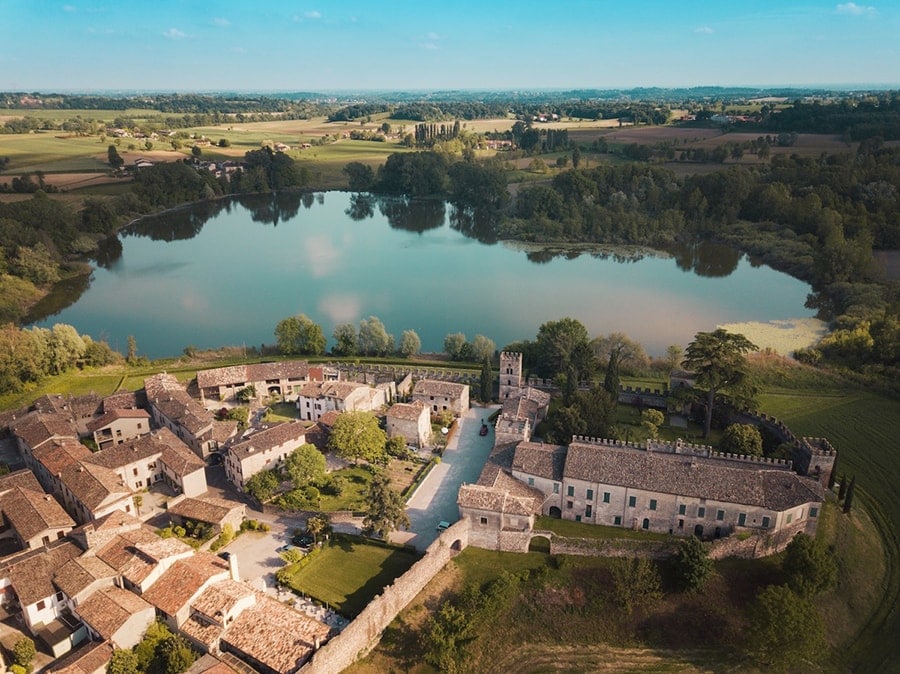
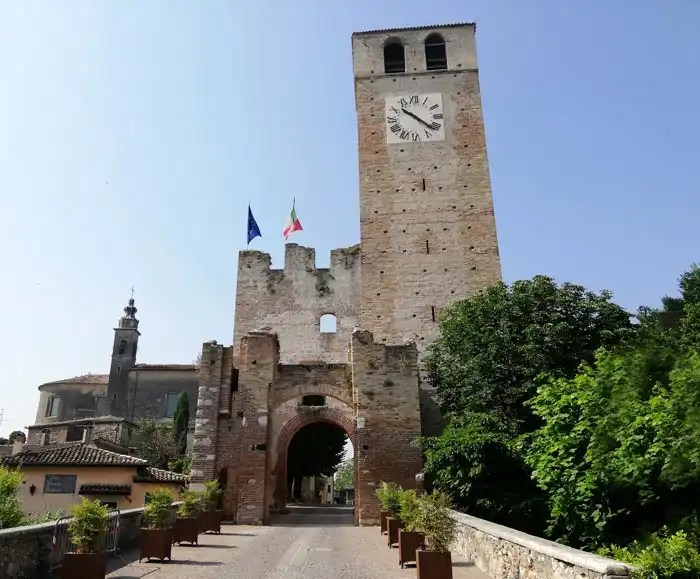
Volta Mantovana.
Volta Mantovana, enjoying a particularly pleasant geographical position, commonly found in almost all the Mantuan villages, has proved to be, since the earliest times, a favorable settlement to be inhabited.
What makes Volta a destination worth stopping for is Palazzo Gonzaga: it is known that this patronymic is quite widespread in the area and that it is always a guarantee of vestiges of great artistic and historical value. On the territory in which it settled and spread, the Gonzaga family has in fact continuously held a secular dominion, consequently allowing a development of traditions and customs that have been handed down almost intact to our days.
The real jewel of this locality are undoubtedly the gardens of the Palace; built in 1527, they are a beautiful example of an Italian garden, developed on two terraces with balustrades, connected to each other by a staircase. Only in more recent times were two lower crags added for the needs of the Cavriani marquises who lived in the building; they were in fact designed to accommodate the open-air theater for guests, between the exedra and the loggia that delimit them on the short sides and which had the function of scenography and stage.
The Mantua area is famous among other things for its gastronomic traditions, whose origins are to be found in the ancient attention that the noble dynasty showed towards good food and hospitality. In fact, the town recalls the existence of a typical local wine, now extinct, which was also appreciated by the French court: Vernazza di Volta Mantovana. Historical re-enactments of ancient banquets, but above all a widespread diffusion of clubs, including restaurants and trattorias, perpetuate flavors that were once known by few and a variety of dishes based on local products, the first pumpkin, which rightly make this land famous.
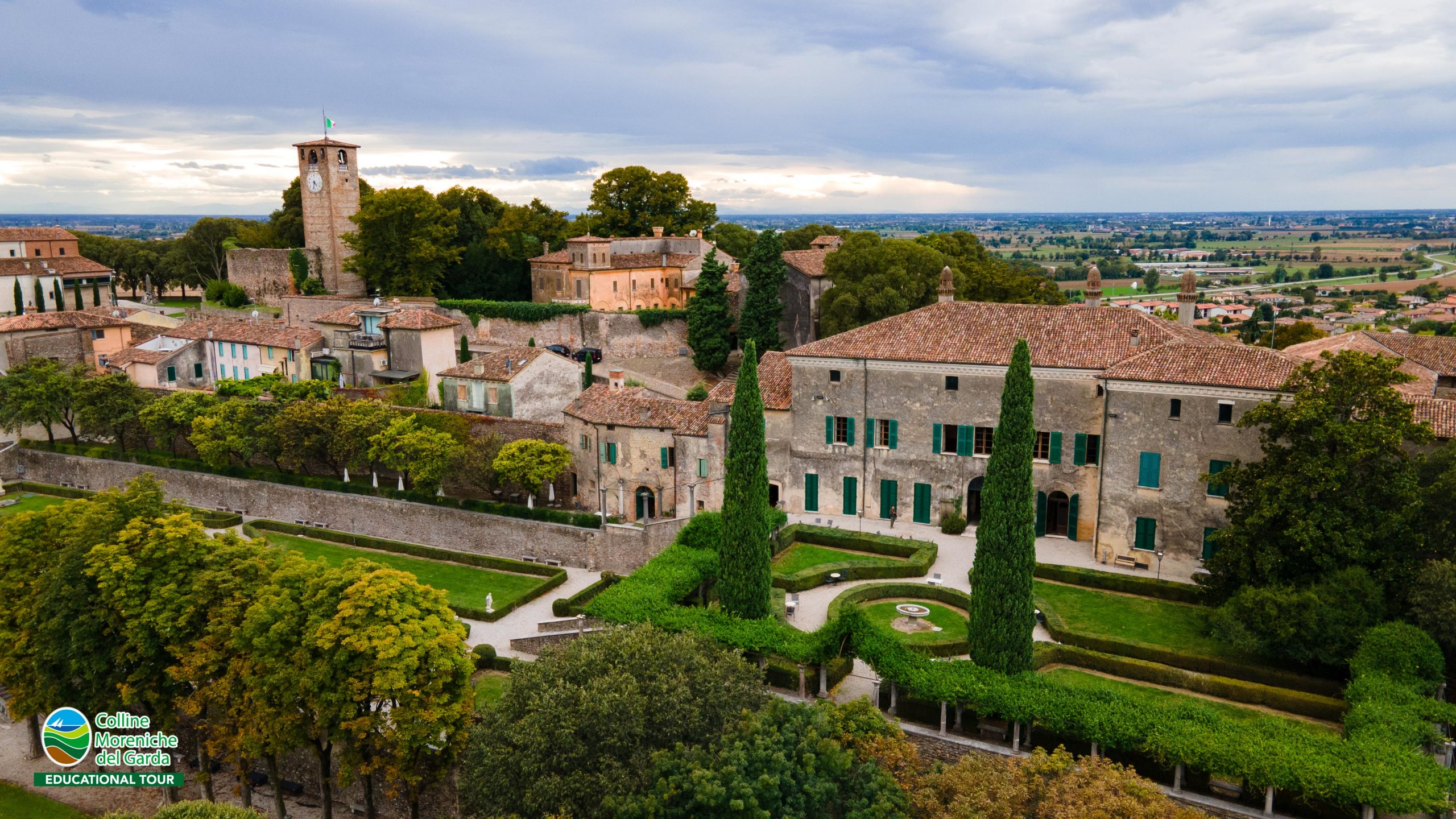
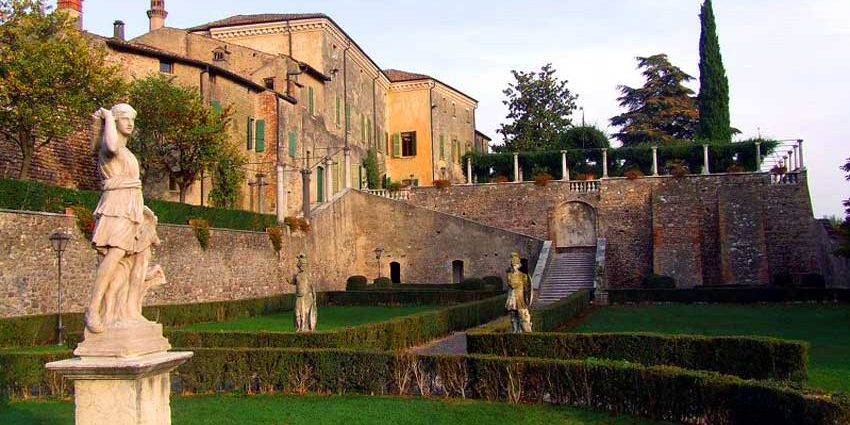
Solferino.
Solferino, whose name is indistinguishable from the epic battle of June 24, 1859 which decided the fate of the Second Italian War of Independence by forcing the Austrians to abandon Lombardy and fall back over the Mincio river, is a small and beautiful village on the Morainic hills of the Lake Garda.
Solferino was once gathered around the sixteenth-century stronghold of Orazio Gonzaga, the castle of which only the entrance door, a part of the walls, the watchtower and the church of San Nicola remain, which stand today in Piazza Castello, a one of the most beautiful in the Mantua area: rectangular in shape, partly surrounded by ancient walls and partly by a curtain of houses, the square allows you to enjoy a wide panorama that goes beyond Lake Garda.
The highest hill in the country rises only 206 meters above sea level, but allows you to dominate a vast panorama. Up there since 1022 stands a fortress, a majestic square building 23 meters high, acquired in 1315 by the lord of Mantua Rinaldo Bonacolsi known as “Passerino”, restored in 1611, and which in the Risorgimento climate was called “The Spy of Italy“, as its summit terrace was ideal for controlling movements towards the Veneto and as far as Lake Garda. Surrounded by the sharp cypresses of a large park, the Rocca was purchased and renovated in 1880 by the Solferino and San Martino Society. In its small museum there are relics found on the battlefield, while along the ramp leading to the panoramic terrace there are documents relating to the history of the fortress and the mint of the Gonzaga of Solferino and in the “Sala dei Sovrani” portraits of Vittorio Emanuele stand out. II and Napoleon III, the victorious sovereigns in the battle of Solferino on the troops of Franz Joseph of Austria.
The historical relevance of that famous war episode means that every corner of the country in some way remembers it. First of all with the Museum of the Risorgimento of Solferino and San Martino, founded in 1931, whose three rooms display documents, relics, weapons and paintings relating to the battle of June 24, 1859 and to the Risorgimento in general, with relics from Italian history from 1796 to 1870, or from Napoleon’s first descent in Italy to the capture of Rome. Visitors can linger in front of French carbines, Austrian rifles, Italian muskets. There are also armor plates of the French Guard, the complete uniforms of the French Zouaves with red trousers and blue jackets, the white uniforms of the Austrians, everyday objects and the personal booklets of French soldiers, three puppets that reproduce the uniforms of French soldiers. The comparison between a four-pound French cannon with French rifled barrel and an Austrian 150 mm smooth-barreled howitzer is interesting: the first with its rifled barrel ensured a double range, up to three kilometers away, and was decisive in ensuring victory to the French. Among the documents displayed in the windows, an autographed order from Napoleon III, an entrance ticket to the military hospital and even a copy of a Persian newspaper reporting the news of the battle. Finally, in addition to canvases depicting the onslaught of the Zouaves, there are also noteworthy six portraits of French generals, the work of the Venetian painter Giulio Carlini. Next to the Museum (which has a branch in San Martino della Battaglia, in the municipality of Desenzano – BS), a slight slope and an avenue of cypresses lead to the small church of San Pietro in Vincoli, transformed in 1870 by the Society into the Ossuary Chapel in which 1413 skulls are preserved in the apse, arranged without distinction of nationality, in addition to the remains of about 7,000 who died in the battle (only four skeletons have been reassembled). To the left of the entrance there is a bronze bust of Napoleon III placed on the centenary of the emperor’s death, on the right a small stone pyramid that commemorates the French general Auger who was wounded on 24 June in Cà Morino and then died in Castiglione delle Stiviere. On the facade of the church two mosaics depict St. Peter and the Redeemer, surmounted by a statue of the Madonna with two angels. Five busts of as many French generals who fell on the field in the Italian campaign (two of them in Solferino) face each other at the entrance to the Temple.
Solferino antiques market: if you are fond of antiques, or simply curious, mark the second Sunday of each month (from March to December) on the calendar and spend a few hours in the sixteenth-century Piazza Castello. It will be a pleasant surprise to come across a rare piece or some particular object!
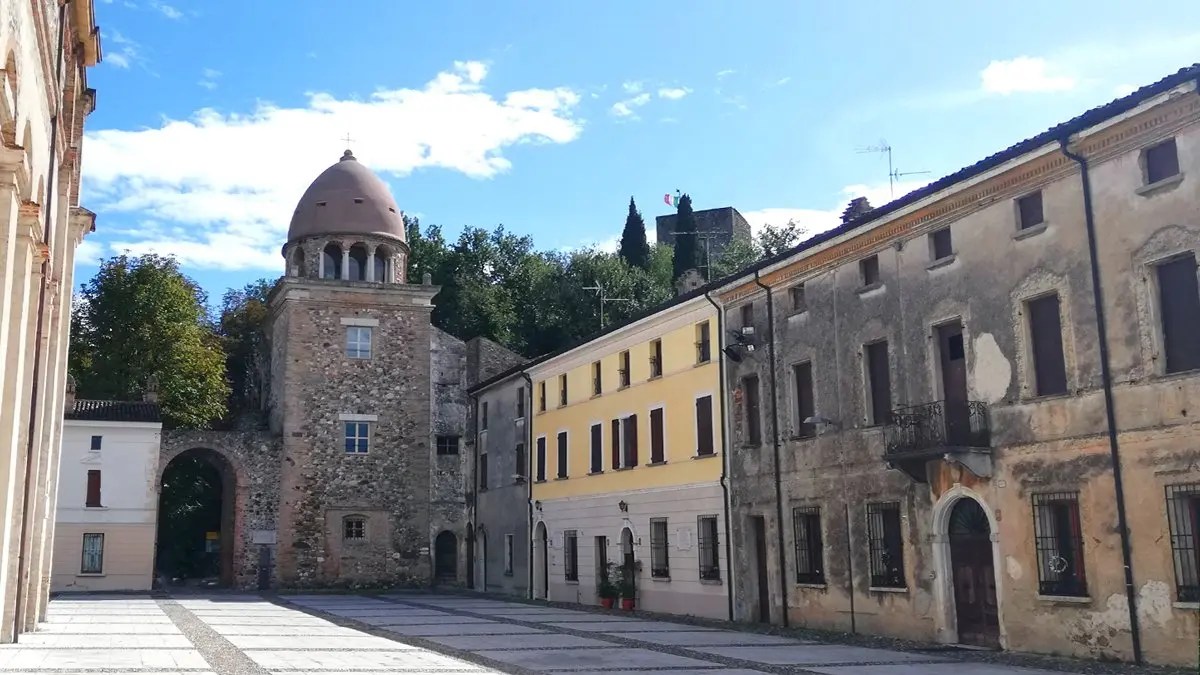
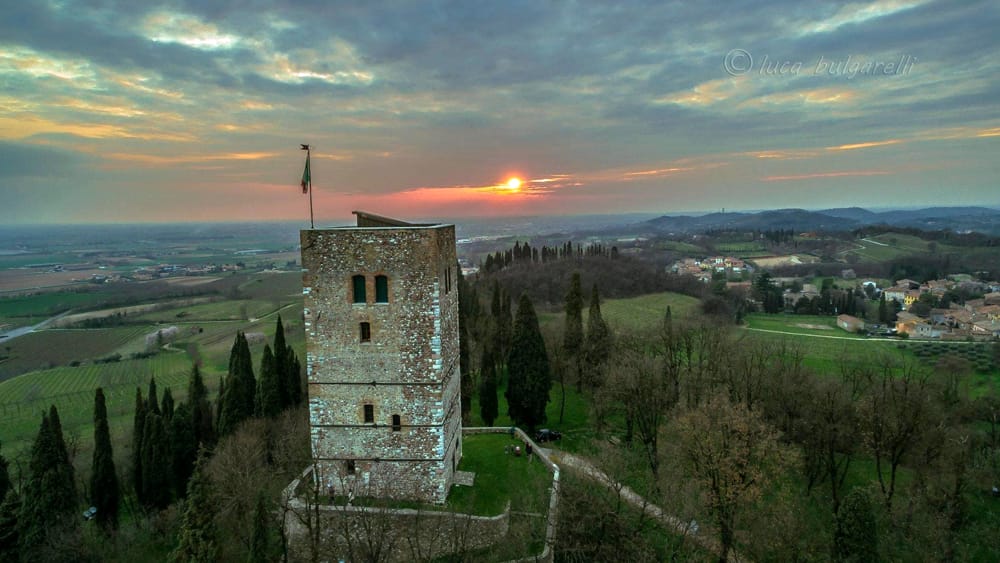
Monzambano.
Monzambano is beautifully set among the Morainic Hills south of Lake Garda. Its most representative architectural structure is the Complex of San Michele, a set of buildings that has characterized the small village since ancient times and which consists mainly of a castle and a church consecrated to the Archangel Michael. The latter has existed at least since 1400, but was rebuilt and enlarged during the eighteenth century, more precisely between 1743 and 1777, as well demonstrated by a facade that clearly refers to the imagination and creativity typical of the Baroque style. Although there are also some references to neoclassicism, for example by observing the high base or the triangular tympanum. Inside, the church has a single nave structure (at the time known as “preaching”), with a barrel vault supported by chapels in the shape of niches that act as a buttress. On the sides of the nave there are six chapels with different altars dedicated to the Crucifix, the Virgin and various Saints, as well as embellished with various works of art of the period.
As already mentioned, next to the church stands the Castle of Monzambano, an ancient stronghold located on a hill overlooking the center of the village and which still retains its urban layout unchanged. The building dates back to around the 11th century and in all likelihood was created to defend the population from barbarian invasions; over the centuries it has belonged to several local noble families, before passing under the direct control of the Republic of Venice starting from 1495 and, finally, returning to Mantua in the Napoleonic era.
Another place strongly linked to the history of Monzambano and its ability to defend itself from foreign invasions is the Ponte dei Carabinieri, a structure famous for having been the scene of one of the most important victories brought home by local troops: during the Third War of independence (precisely on 24 June 1866) the Austrian troops invaded the town, but the infantry and cavalry led by General Giuseppe Salvatore Pianell repulsed the offensive, safeguarding the independence of the territory.
The landscape of Monzambano is rich in vines and olive trees that grow strong and luxuriant thanks to a rather mild climate and it is no coincidence that the municipality has obtained both the title of “City of wine” and that of “City of oil“. More generally, the entire area of Alto Mantovano is a real treasure chest that contains dozens of absolutely delicious typical products that have entered the local culinary art. In these parts, the pillar of the table is undoubtedly the pork, of which nothing is thrown away and from which high quality cold cuts are made such as cotechino, raw ham, pancetta and obviously Mantuan salami. Equally noteworthy is the production of Grana Padano cheese, which is widespread throughout the area surrounding Monzambano. If we are talking about pasta we must at least mention the fuiàde (or noodles) dry or in broth and the bìgoi, a very robust type of spaghetti due to the high number of eggs used for its preparation. Pike is the perfect freshwater fish to get in tune with local tradition and is served accompanied by a sauce and fresh, soft or toasted polenta. Finally, the desserts: among the most famous we mention the sùgol, a sweet fairy cream with wheat flour and the chisòle, or the schiacciate, prepared with fresh lard, especially on the occasion of the Feast of Saint Anthony on 17 January.
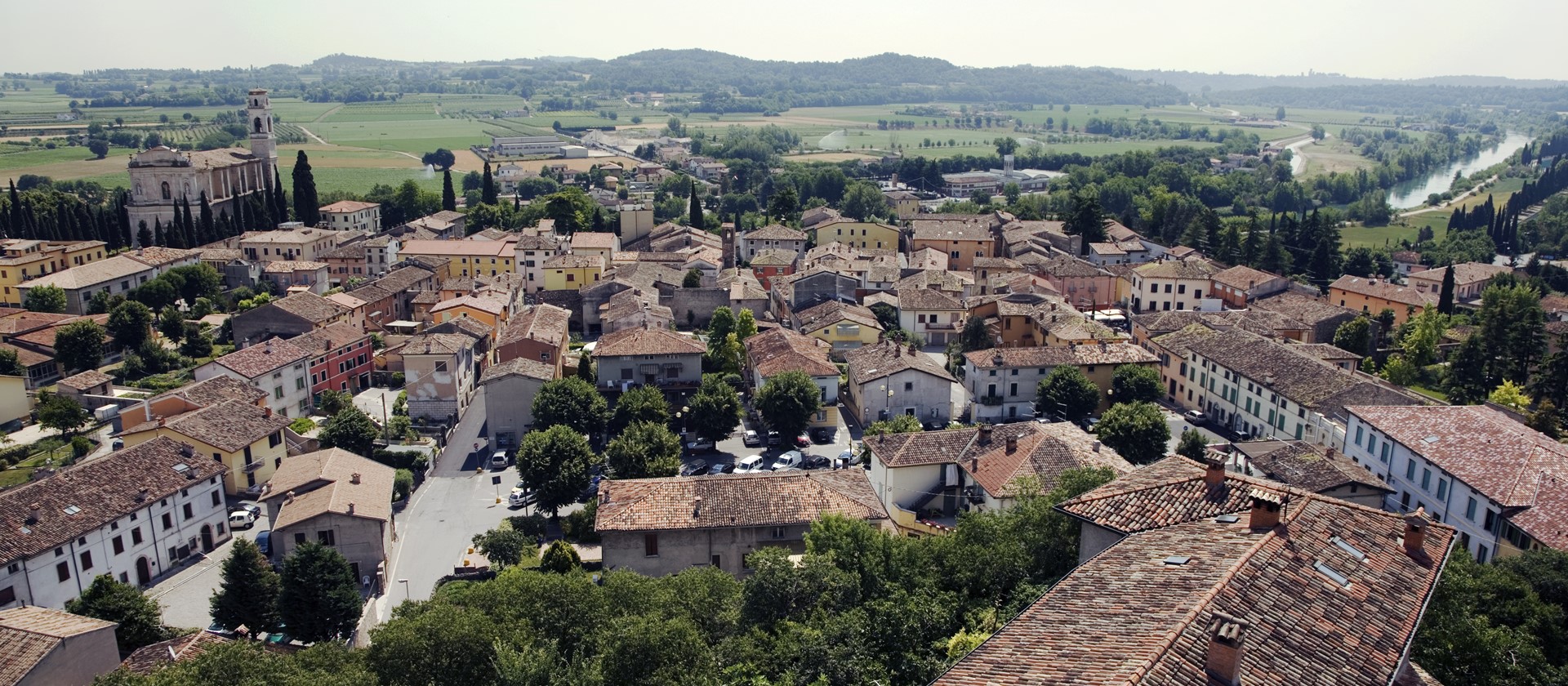
Rivarolo Mantovano.
Between Bozzolo and Commessaggio, just below the Oglio river, is the Municipality of Rivarolo Mantovano. Its name derives from a stream that ran around the ancient parish church of Santa Maria in Ripa d’Adda, which arose outside the current center. Ripa in fact means shore. The coat of arms is a fish that leads back to the local legend of a large fish saving a warrior from battle by bringing him ashore on his back. Territory developed by the Gonzaga family especially by Vespasiano who, as a good architect, draws the plan. The external walls surprise you with the presence of 3 monumental access doors. The most important feature of the urban fabric of the historic center of Rivarolo is undoubtedly the orthogonal layout of its road layouts, which form regular blocks. You reach the main square, once called Piazza Grande (now Piazza Finzi) on which the most important buildings overlook, from the Palazzo Pretorio (now the town hall) to the Palazzo dei Conti Penci, to all the buildings located along the two longer sides, which , in addition to being architecturally significant, they are characterized by a large portico, where the main commercial activities are located. Finally we mention Cividale, a hamlet of Rivarolo, which was the summer residence of the Duke Vespasiano, where he devoted himself to hunting and the entertainment of the time. Do like him and treat yourself to a real duke’s break in this jewel village.
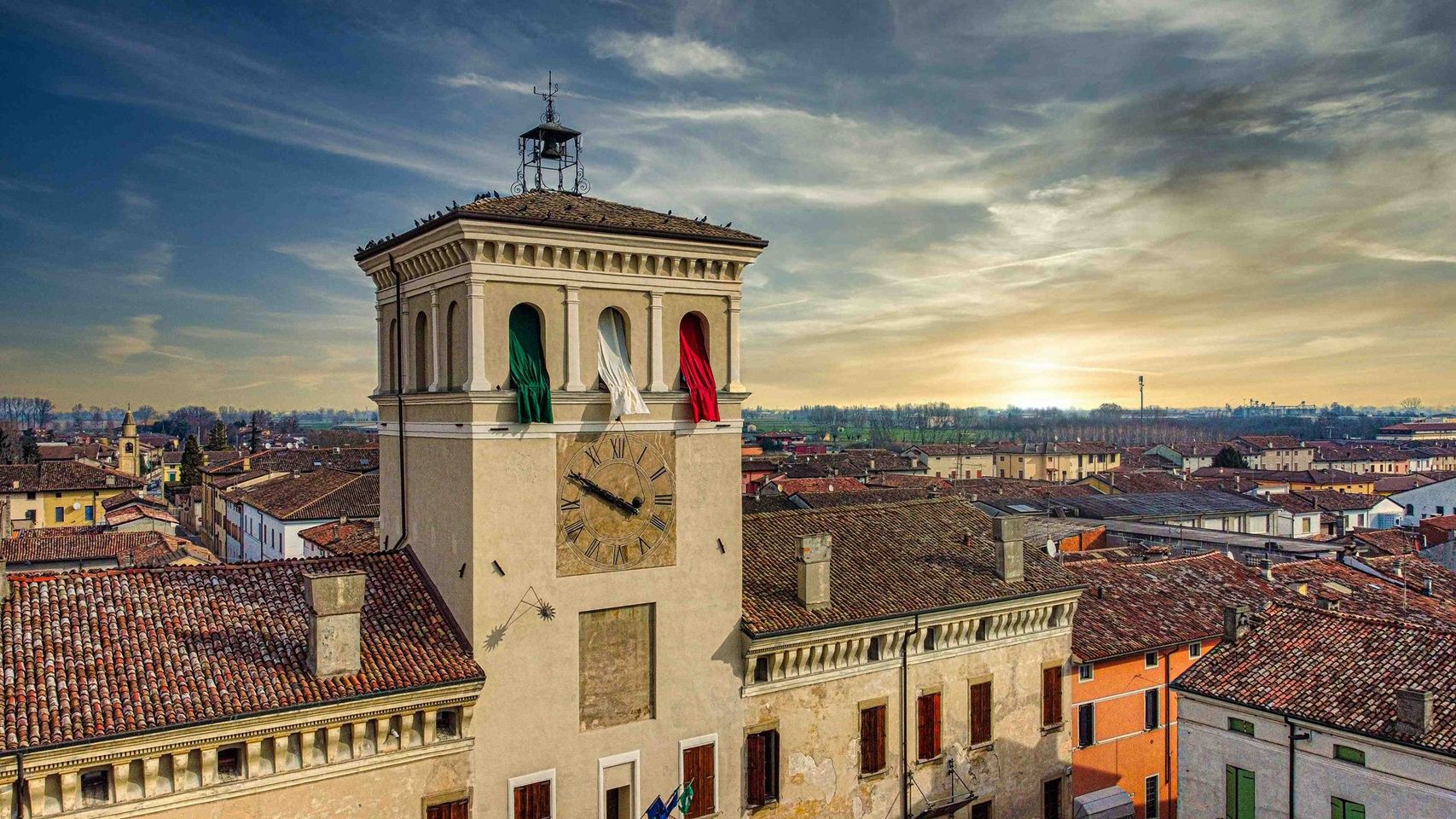
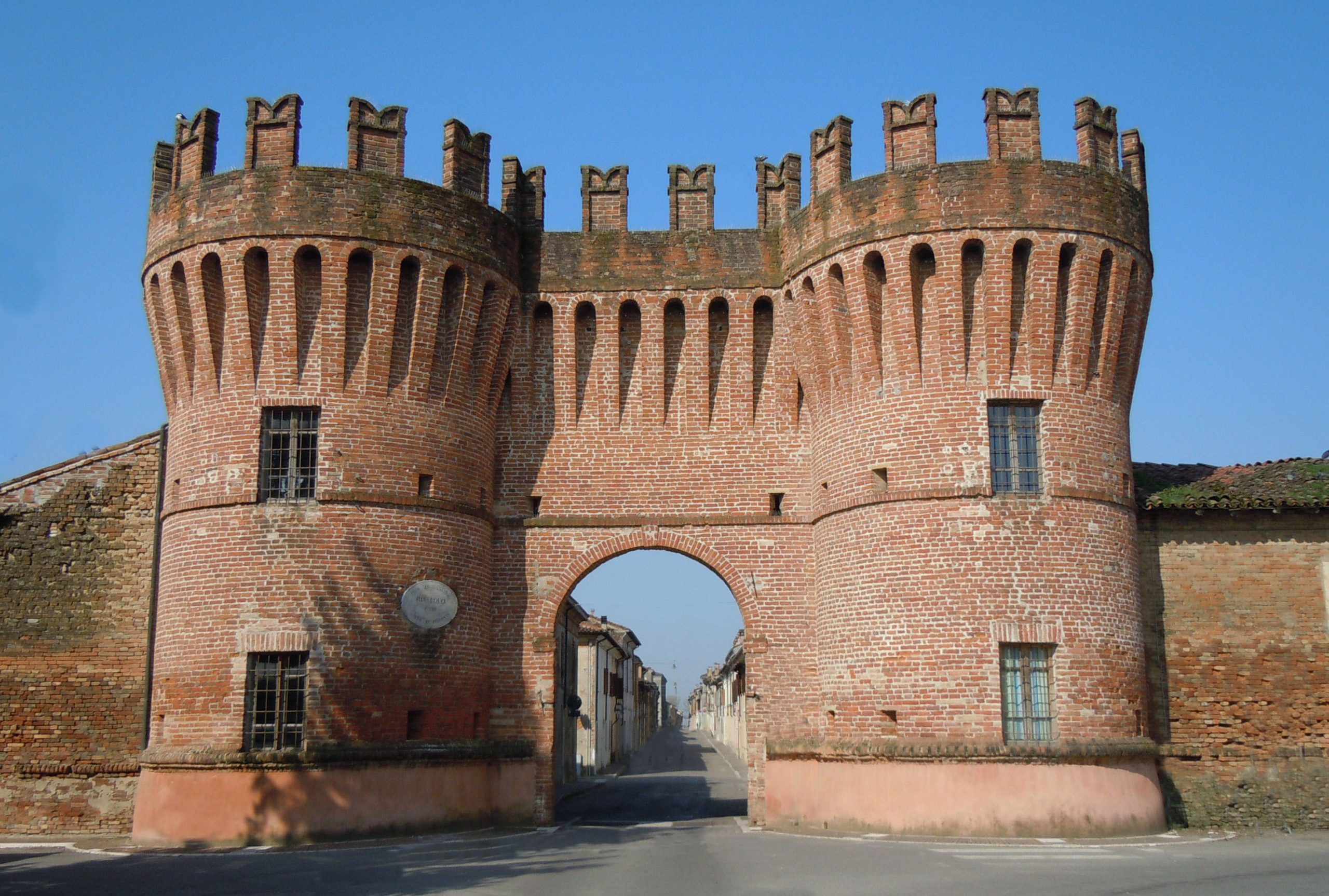
Goito.
Goito is located in a purely flat area and is 15 kilometers from the city of Mantua. The town is located on the banks of the Mincio river, it was the home of Sordello, and known as an important fortress, of which a tower and the checkerboard structure of the village remain.
Built during the Roman period, it is one of the oldest centers in Lombardy.
Crossing the Ponte della Gloria, on the left is the monument to the Bersagliere and on the right the bronze bust of General La Marmora. The Baroque-style basilica of San Pietro was built by Giovanni Maria Borsotto in 1729. Near the church stands Villa Moschini, one of the historic houses built by the Gonzagas which reached its maximum splendor in 1500. Its splendid park is also noteworthy.
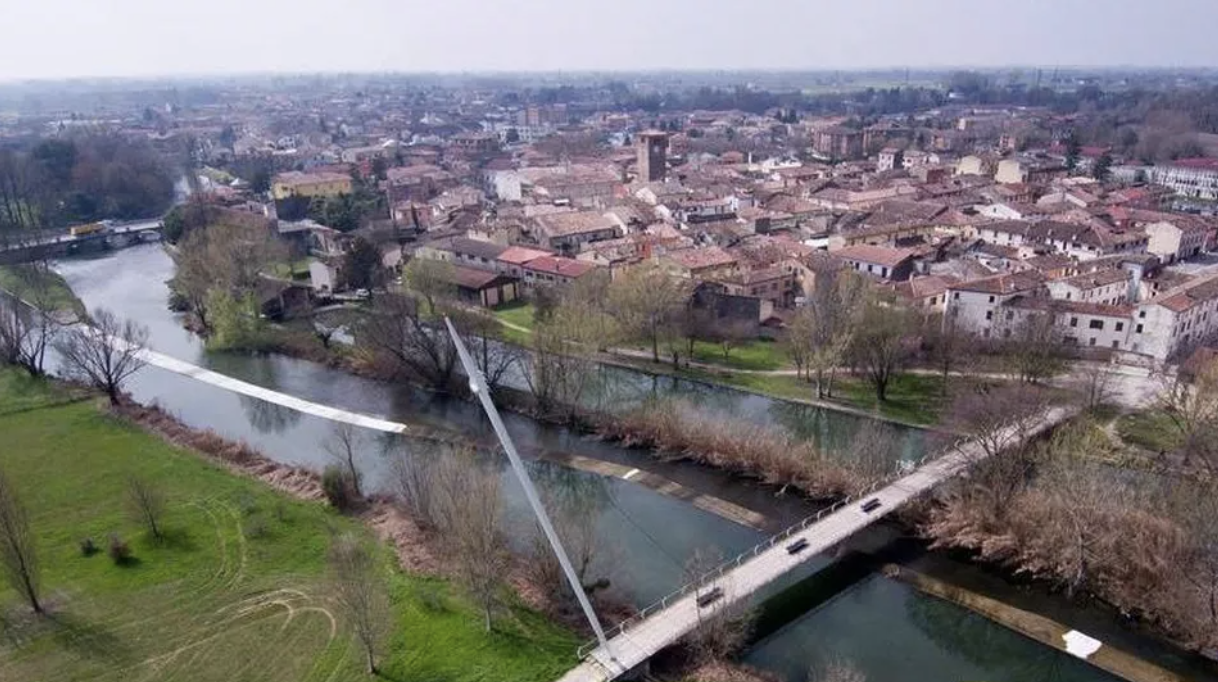
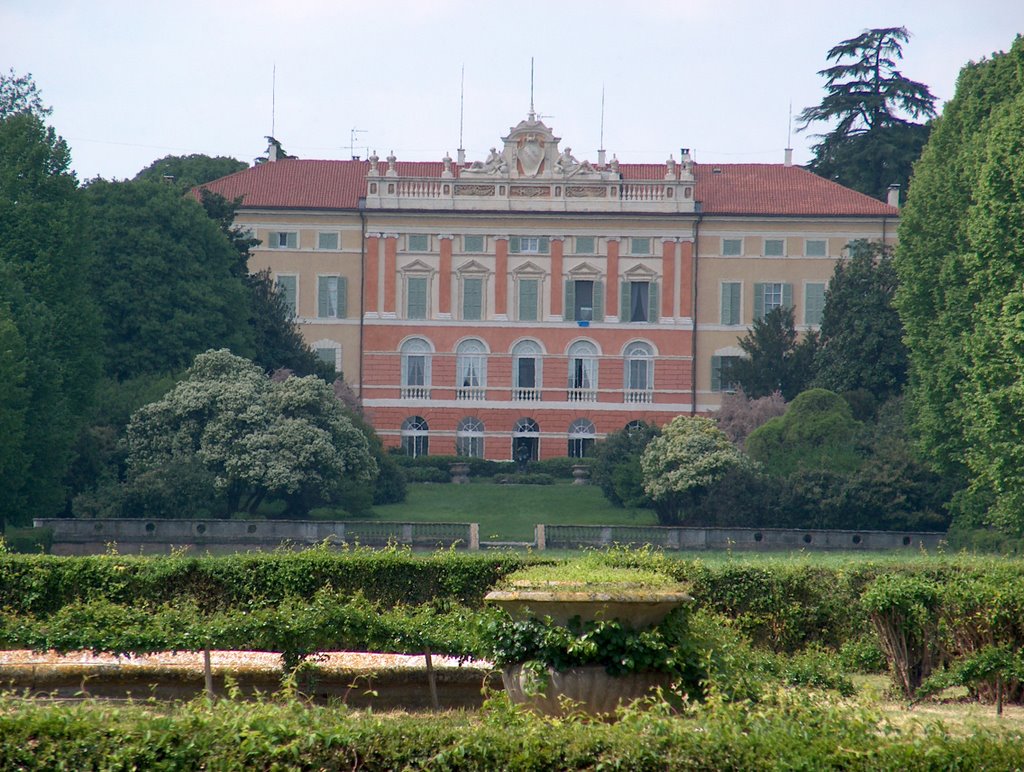
Castel Goffredo.
The territory of Castel Goffredo has been inhabited since prehistoric times and there are vast settlements from the Bronze Age (1800-1200 BC). Important findings have highlighted an Etruscan presence, while there are numerous Roman settlements and the same urban imprint of Castel Goffredo is attributable to this historical period.
This era is also evidenced by various epigraphs, some of which can be traced back to the family of Publio Virgilio Marone, the great Latin poet who, according to Professor Nardoni of the University of Cassino, was born in the Goffredese area. A Lombard bas-relief from the 7th-8th century, kept in the Oratory of San Michele, is the oldest sign of the Christian presence in this community. In the Carolingian age Castel Goffredo belonged to the county of Brescia. Borderland between Brescia, to whose diocese it belonged, and Mantua, it spontaneously donated to the Municipality of Mantua, and then to the Gonzagas, in 1337. After various events (Visconti, Gonzaga, Visconti, Venetian and finally Gonzaga domination) ) in 1515 Castel Goffredo became the capital of a small state, including Castiglione delle Siviere and Solferino, governed by the Marquis Aloysio Gonzaga who was succeeded by his eldest son Alfonso. The latter, for reasons related to the succession of the fiefdom, was assassinated in 1592 in the court of Gambaredolo by his nephew Rodolfo, brother of San Luigi, himself the victim of a popular conspiracy that led to his killing on the threshold of the Prepositurale di Sant ‘ Erasmus on January 3, 1593. Following these events, Castel Goffredo was aggregated to the Duchy of Mantua, with which it passed under Austrian domination in 1707, then French (1801-1814) and then again Austrian. In 1848 Castel Goffredo was the anti-Austrian conspiratorial center of the Alto Mantovano and counted the presence of numerous patriots headed by the castellan Giovanni Acerbi, who later became the steward of Garibaldi’s Thousand.
The conspiracy was discovered and resulted in the tragic page of the Belfiore Martyrs. In 1859, after the battle of Solferino and San Martino which also involved the territory of Castel Goffredo, the city was aggregated to the Kingdom of Sardinia and in 1861 it became part of the Kingdom of Italy. 1925 marked the economic and industrial turning point of Castel Goffredo: in fact, the first hosiery factory, NO.E.MI. destined to write the history of the industrialization of the area.
The heart of the city is the Renaissance Piazza Mazzini, coinciding with the ancient Roman forum, towards which some of the streets of the historic center lead, protected by solid walls until the last century. Along the sides of the rectangle that constitutes the square there are buildings full of history, symbols of city powers.
First of all we mention the Prepositural Church of Sant’Erasmo; in Renaissance style it is arranged asymmetrically with respect to the axis of the square; it was built in the second half of the fifteenth century, enlarged in 1516 and then rebuilt between 1588 and 1590 by Bernardino Facciotto, architect of the Duke of Mantua Guglielmo Gonzaga, by the will of the Marquis Alfonso Gonzaga, lord of Castel Goffredo. It has a façade on two orders with pilasters and a tympanum. The interior is a Latin cross divided into three naves by Botticino marble columns and is rich in artistic testimonies including some variously dated canvases, a wooden crucifix already famous in the fifteenth century for its thaumaturgical manifestations, a beautiful wooden statue of the ‘ 400 depicting the Madonna enthroned with child. Precious are also the marble altars masterfully decorated with inlays and semi-precious stones. The polygonal apse with umbrella vault, some Aloysian epigraphs and the white marble portal (1532) placed on the side of the church, some frescoes of the Sixteenth century and the fifteenth-century bell tower, with mullioned windows and mullioned windows.
The Municipal Palace called the “Casa del Comune” is a building dating back to 1330 and remodeled in 1490 built on the structures of the ancient Palazzo della Ragione of which the façade with part of the loggia remains. In neoclassical style, the façade is divided into two parts: on the ground floor the “Loggia delle grida” where the neighborhood met and above the council chamber with its frescoed ceiling which housed the municipal theater in the nineteenth century and currently exhibits the municipal collection of art with works concerning Castel Goffredo of the twentieth century.
The Gonzaga-Acerbi Palace, dating back to 1350, occupies the entire northern front of Piazza Mazzini. In neoclassical style, it underwent several changes, the most important in the eighteenth century. It was the residence of all the lords who succeeded one another in Castel Goffredo, starting with the Gonzagas of Mantua.
The Civic Tower, of medieval origin, belonged to the first walls of Castel Goffredo, with its 27 meters stands out over Piazza Mazzini and is popularly considered the symbol of Castel Goffredo. Its foundation dates back to the 13th century and the public clock has been housed there since 1438.
The Torrazzo, of medieval construction with a cantilevered crown supported by corbels, was probably built in the second half of the 14th century as the residence of the vicar representing the Gonzagas of Mantua. On the south side run the medieval arcades, paved in 1838 with Sarnico sandstone slabs, under which, even today, the windows of the numerous shops open up. Full of charm is the ancient Castelvecchio urban network, which was, before 1500, the urban center of the city.
In the historic center, you can visit two other sacred buildings: the Church of the Disciplini, located in the homonymous Via Disciplini. In Renaissance style, it was finished in 1587 with a single nave on behalf of the “Confraternita dei Disciplini”. It has a seventeenth-century bell tower and inside there are remains of frescoes from the end of the sixteenth century on the life of St. John the Baptist and the valuable high altar in polychrome marble from 1772, the work of Angelo and Giambattista Lepreni from Rezzato. Now deconsecrated, it is currently the site of important exhibitions and cultural events. The Church of San Giuseppe, in Baroque style located in via Andrea Botturi; it was in the sixteenth century a building used as stables and artillery of the Gonzagas. By decree of 1728 of Prince Philip of Assia, governor of Mantua, it was ceded to the “Compagnia del Santissimo Sacramento” which, in 1729, transformed it into a place of worship, a function that it continues to hold.
Among the palaces we mention Corte Gambaredolo, a typical Renaissance court built on the eastern outskirts of the city in via Ceresara at the beginning of the sixteenth century by the will of the Marquis Aloisio Gonzaga, it was the holiday residence of the “Gonzaga di Castel Goffredo” lords. Here, in 1592, Alfonso Gonzaga, Marquis of Castel Goffredo was assassinated. Caterina Gonzaga, daughter of Alfonso, also resided there, who in 1615 had the Oratory of San Carlo built. It is currently in partial disuse. Palazzo Riva, built in the early sixteenth century and located between piazza Mazzini and via Roma, was the town residence of the noble Riva family. Consisting of two buildings, the marble portal, a loggia with marble columns and a hall embellished with frescoes and stuccoes are still preserved on the ground floor. Here in May 1848, Vittorio Emanuele II, the future king of Italy, was welcomed as a guest of Bartolomeo Riva. Villa Beffa in Renaissance style from the second half of the 16th century, is located in via Beffa, 2 km from the center and belonged to the Beffa family, who have lived in Castel Goffredo since 1337.
Culinary specialty of Castel Goffredo: Tortello amaro is a type of filled pasta similar to ravioli and is a traditional food product recognized by the Lombardy Region, typical of the Castel Goffredo area only. It is so called due to the presence in the filling of balsamite, an aromatic herb locally called bitter herb, also known as St. Peter’s wort. You can taste it in the various taverns and restaurants around the area or buy a nice tray at the local delicatessens (one can be found right in the central Piazza Mazzini).
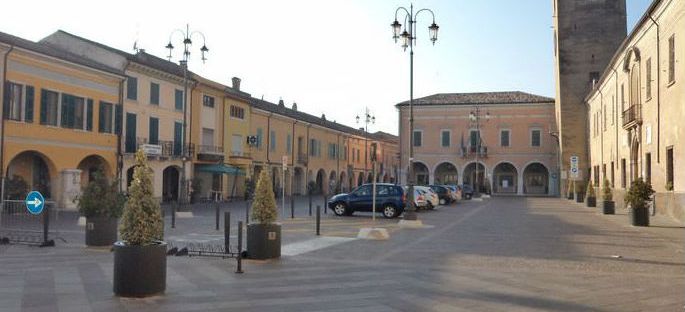
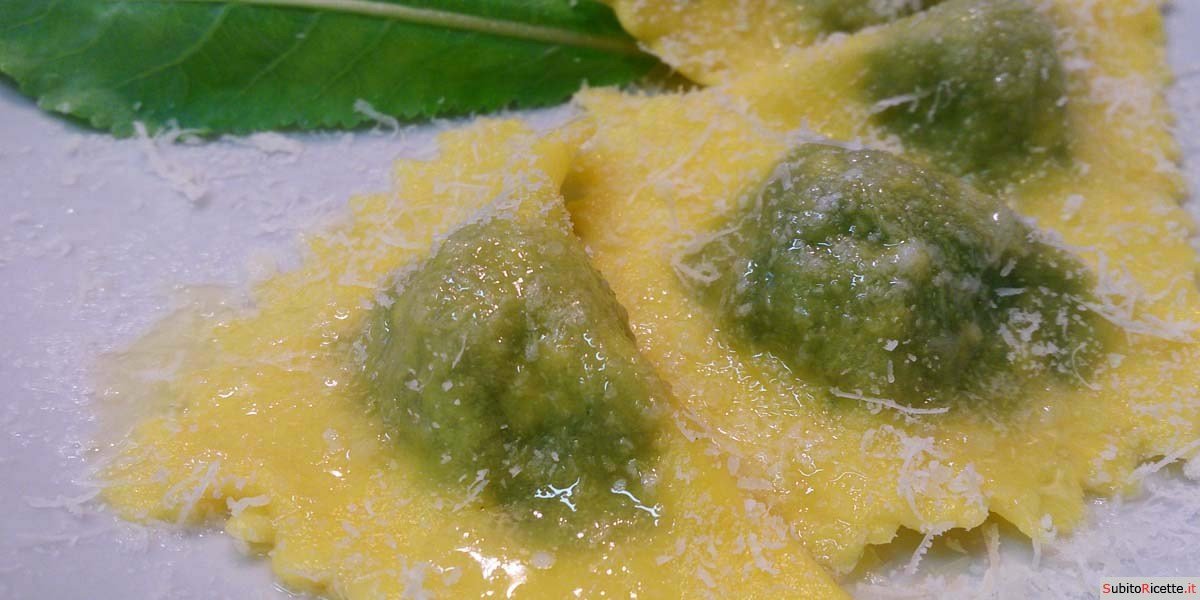
Le Bine Nature Reserve.
This site has nothing to do with the villages but, since we are in the area, it would be a shame not to name it for a nice walk surrounded by nature. Le Bine was one of the first WWF Italy Oases: it was born in the 1970s to protect the wetland that originated in the 18th century. Over the years, the area, which has now also become the regional nature reserve of the Oglio Sud Park, has considerably changed its appearance, taking on the current one, characterized by new wetlands, large reforested areas and a completely renovated farmhouse.
The route starts at the bridge over the Oglio river, between the municipalities of Calvatone and Acquanegra sul Chiese (MN), where you can park in the square in front of the reserve entrance. The journey that takes you to Cascina Le Bine is on a dirt road surrounded by greenery and surrounded by woods of native trees and shrubs, planted since 1995, replacing the classic industrial poplar groves.
Once at the farmhouse, you can continue the journey continuing towards the river, to arrive at the embankment, where, turning left, you will walk along it to the connecting road between Calvatone and Acquanegra sul Chiese. At this point, you can cross the road and take a short section of the pedestrian cycle next to the provincial road, which will take you to the starting point in a few minutes. The entire route stretches over 5 km in length for about an hour and a half.
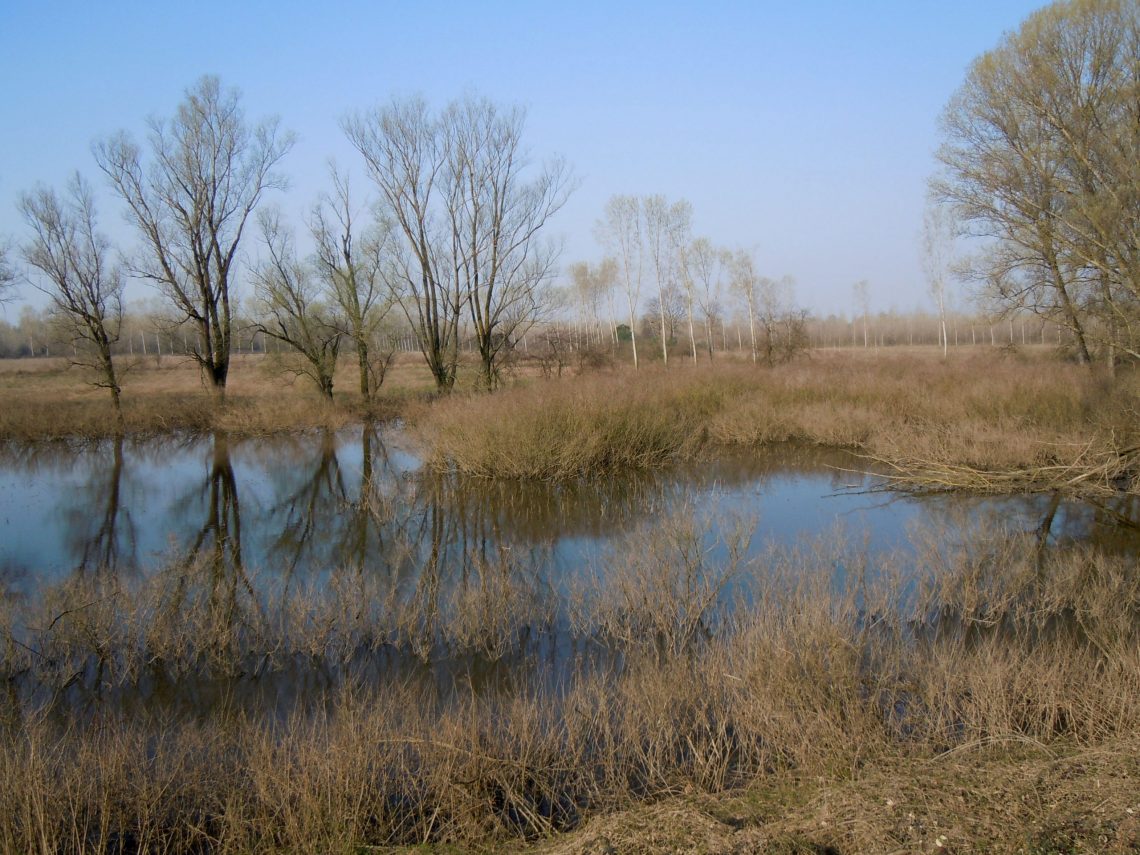
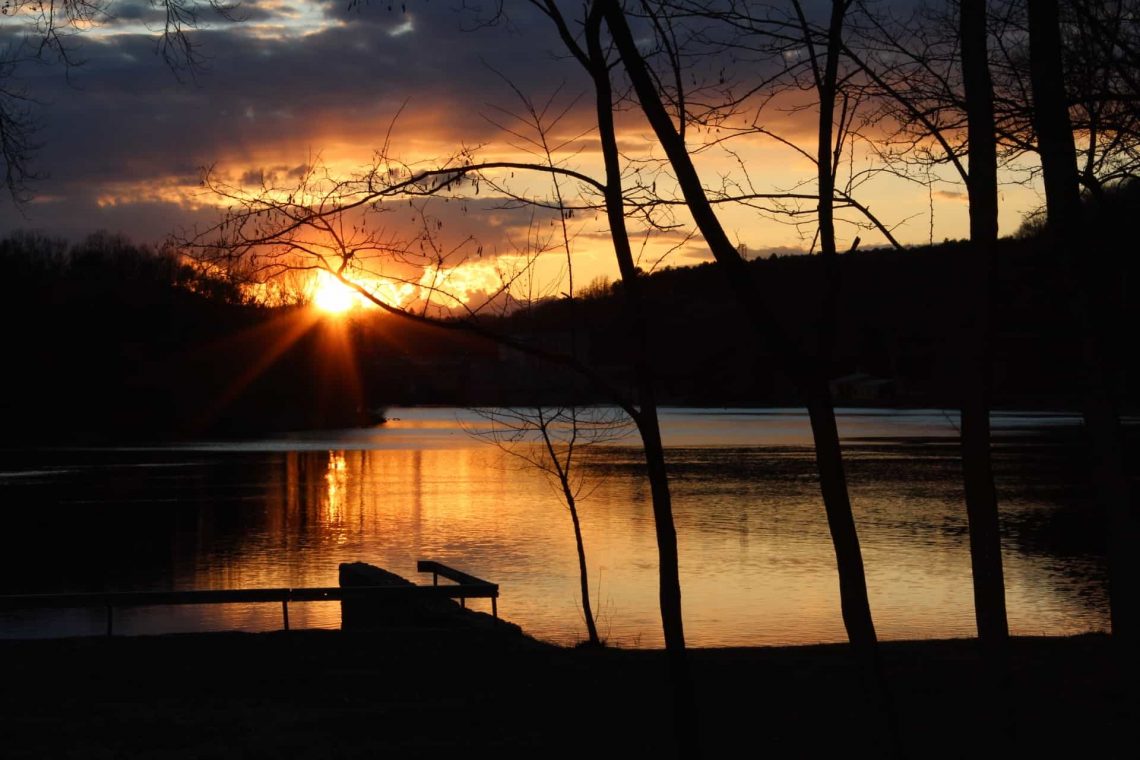
A long reading to tell how beautiful our Italy is, also made up of small realities that sometimes shine more than a metropolis.
See you next time dear Outdoors!
Silvia Turazza – Garda Outdoors editorial staff
